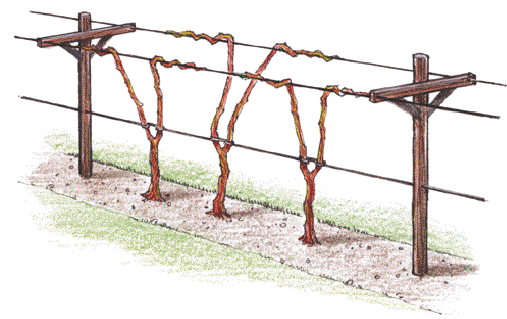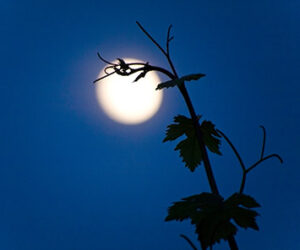One of my favorite columns to write every year is the Question and Answer installment. I have a clear sense of what I’d like to discuss and teach each year, and when the questions come in, I’m always surprised that there are avenues of viticultural discussion that I’ve overlooked.
Every year since I’ve been writing this column the questions become more and more specific and educated. Home winegrowers are increasing in sophistication, and I suspect that the wines coming out of backyards are improving because of your hard work, study and experimentation. Thanks to all those backyard wine warriors for elevating our craft and creating a community that helps all those that seek to make quality wine in their backyards. You are the pioneers, planting vineyards where none have been before, and finding ground that will lead us to the next generation of great wines.
Trellising Question
What are the pros and cons of the Geneva Double Curtain Trellis and where can the cross arms be found?
– Ed Kaarela
Wes says: The Geneva Double Curtain (GDC) is an advanced trellising system for winegrapes that is appropriate for high-vigor soils and climates. The process of matching vineyard site with trellis type is one of the most important and complicated decisions that occurs in the planning and installation phases of planting a vineyard.
GDC trellising was developed in New York State and was first described in a 1966 study by Nelson Shaulis at Cornell University. The trellis was first used with Concord grapes and showed the beneficial effects of splitting the canopy into two separate curtains of foliage that allows more sun penetration into the interior, increasing bud fruitfulness in subsequent vintages and allowing a doubled fruiting zone. Compared to a sprawl or vertical shoot system, Shaulis found GDC yields in both V. labrusca and V. vinifera increased 30%-90%, a significant increase if the soil and climate offer moderate high to high vigor conditions. Again, if you don’t anticipate a high level of vigor, a split canopy system is not appropriate.
The GDC has fruiting wires about 3 feet (~1 m) apart, and high fruiting wires (4-5 feet/1.2-1.5 m) that allow tractor tires to roll under the cordons. Vines are spur pruned, and positions are encouraged to point down towards the vineyard floor to slow growth and vigor. Rows are generally wide and this system is used for increased yield and mechanization of pre-pruning and harvest. The largest area of GDC in the world is in Northern Italy in high production areas known for table wine.
As far as pros and cons: pros would include higher yield and better solar radiation on renewal buds for a high vigor vineyard. Cons would be the difficulty of a very professional installation and early pruning/training. Another con would be if you put this system in a moderate or low vigor site it would likely fail, as the amount of buds retained at pruning requires high vigor sites to fill in a double canopy. I have harvested GDC fruit, and it is a bit difficult to get inside of the vine, as it makes an entire fort of foliage, and harvest can be dusty and buggy as you have to get inside the canopy in many instances to get at the fruit.
There is a drawing of a GDC found below. It is a difficult system to get set up, pruned and producing. Not easy for someone who hasn’t seen it done. You may have to visit a vineyard where they are using this trellis type and get some professional guidance before jumping in.
The crossarms should be about 36 to 42 inches (91 to 107 cm) and can be ordered through a vineyard supply business.

What to Plant
I live in Wyoming, not a prime grape growing area, but there are many hybrids that are showing promise. I am in the process of starting a small backyard vineyard – about half of an acre — that will consist of mainly hybrids from the University of Minnesota. My highest priority is to make the best wine possible. The next priority would be to have as many varieties as possible. What I would like to know is, in order to make the best wine, would it better to make this in larger quantities or can this be done with a few vines? Is it easier to make quality wine in larger batches or can I still make high quality wine in small batches and plant more varieties in my vineyard? If I have room for about 100 vines would I be better off to plant, say, 50 vines of two different varieties, or could I make just as good of wine if I planted 10 vines of 10 different varieties?
– Jared in Wyoming
Wes says: Your consideration shows that you are thinking about this correctly, and I have great faith that your ideas (and vineyard) will bear fruit. I have always believed that making larger quantities of wine always improves quality. My normal suggestion for home winemakers is to grow or buy enough fruit to make a full 60-gallon (227-L) barrel, as I’ve had limited success with making smaller lots of wine. I always say that one of the greatest miracles in winemaking is someone who can make great, sound wine in a 5-gallon (19-L) carboy. It happens, just not to me! I would suggest either plant 100 of the same vines, or split 50/50 with two varietals that can be blended to make a better wine than the two separately.
The other side of the coin is determining vine varietals that will make sound wine in your neighborhood of Wyoming. For the future, it may be better to plant all 10 varieties, see which do the best, and then slowly graft out the underachievers with the varietals that are well adapted/suited to your soil and climate. So the final answer is determined by whether you want to make good wine from more fruit, to make a drinkable wine in a few years, or whether you want to be a pioneer and guide future vineyards by way of your experimentation. Perhaps someone in your county has already done the experimentation and you can benefit from researching and seeking out other home wine growers near you. My final answer, though, would lean towards focusing on one or two varietals to keep the wine batches as large as possible. One hundred vines with a good yield (5 lb./2.3 kg of sound fruit per plant or more), may give you enough fruit to make a half barrel (30 gallons/114 L), which would be large enough to keep sound with good topping and an SO2 regime, and would provide enough wine to drink and give as gifts.
How much should I grow?
I gather it takes about 100 lbs. (45 kg) of grapes on stem to make 5 gallons (19 L) of wine. But, roughly speaking, what should you expect a five- or six-year-old vine to produce pound-wise? I am planting my first mini vineyard to make wine for home consumption, and want to know how many vines I should plant of each variety so that I can make at least a 5-gallon (19-L) batch, allowing for what I lose to birds and other critters.
– Barry from California
Wes says: First: never let those critters get your fruit. Backyard vineyards can be protected much easier than commercial vineyards. Trap and poison those gophers and squirrels, use a dog to scare away larger predators and net those vines to keep the fruit for your wine glass. Never concede to the critters, soldier!
With decent soil and good practices you should be able to realize about 5 pounds (2.3 kg) per vine in a backyard vineyard when your crop is saved from pests and mildew/rot. Some higher vigor sites could see yields of double that, and young vineyards/low vigor sites might only get a few pounds per vine or even less if something goes wrong. Five pounds (2.3 kg) a plant on an 8 foot x 4 foot (2.4 x 1.2 m) spacing is around 3.5 tons (3.2 metric tons) per acre, which in a high quality growing area is considered a good yield.
So to make sure you get that carboy filled, let’s assume you will need five full 5-gallon (19-L) buckets of fruit weighing at least 20 lb. (9 kg) each. Choose a varietal with heavy clusters, like Cabernet, Grenache or Syrah, and that will help a lot. Then assume you will need at least 25 vines to get there in a good year. If you have the room, I would try 50 vines. In a lean year you will get one carboy, and in a heavy year maybe two! Focus on a single varietal to help you learn more about what that specific cultivar needs.
Do we need deer fencing?
We have four acres and want to plant about 11⁄2 to 2 acres. We’re not fenced. Will we need fencing to keep out the deer? Will all the vines have to go into gopher baskets? Should we dig for a well or pay for city water (that we already have but it’s pricey).
-Deborah Cash (in Atascadero — Central Coast, California)
Wes says: I have family in Atascadero, and there are a whole lot of deer in that city, especially in the rural areas, and they seem to me to have little fear of people and stealing edibles from backyards. You will certainly need deer fencing and/or a dedicated guard dog for the vines. You can also get a depradation permit if it is allowed where you live, which would solve your problem and add freezers full of delicious venison to your diet. For some reason we’ve never seen a deer within the boundaries of Clos Pepe. We expect it has something to do with the five dogs and twenty-three firearms present. Plus, venison is perfect with Pinot Noir, and we love to eat!
If pocket gophers are as prevalent up there as they are down here, gopher control will have to be maintained. The ground squirrels are problematic as well — they can be trapped or hunted. Gopher baskets will protect the taproot of grapevines, although it will not keep the vines completely safe. I have been told that crushed wine bottle glass tossed in the hole at planting is another deterrent that helps — but active trapping, poisoning, etc is necessary to keep vertebrate pest populations at manageable levels.
Gopher snakes, ferrets, badgers, hawks, eagles, falcons, wild/house/feral cats, dogs and even humans with weaponry can all have a positive impact on pest populations, so make sure to make your vineyard amenable to these awesome, free employees.
As far as the water goes, I would send a sample of the city water to FGL Labs (fglinc.com) and ask to have it tested for “varietal winegrape irrigation suitability.” If the water is good there is no reason to dig a well. But you will also need to know how many gallons per minute you get from the municipal water, and whether that will be enough to adequately water the vineyard. Will you need frost protection? That’s a higher flow rate. I recommend immediately ordering the “Best of WineMaker Guide to Growing Grapes” on the Web at www.winemakermag.com/store. That resource, which is a collection of some of my best “Backyard Vines” columns, will give you a very complete foundation for researching, planning and planting a small commercial vineyard.
Well, that’s it for questions and answers this year. Hope this Q&A session was useful. Keep those questions coming via email, Facebook or Twitter! I’d like to hear some more questions from the Midwest and the East Coast for next year.






